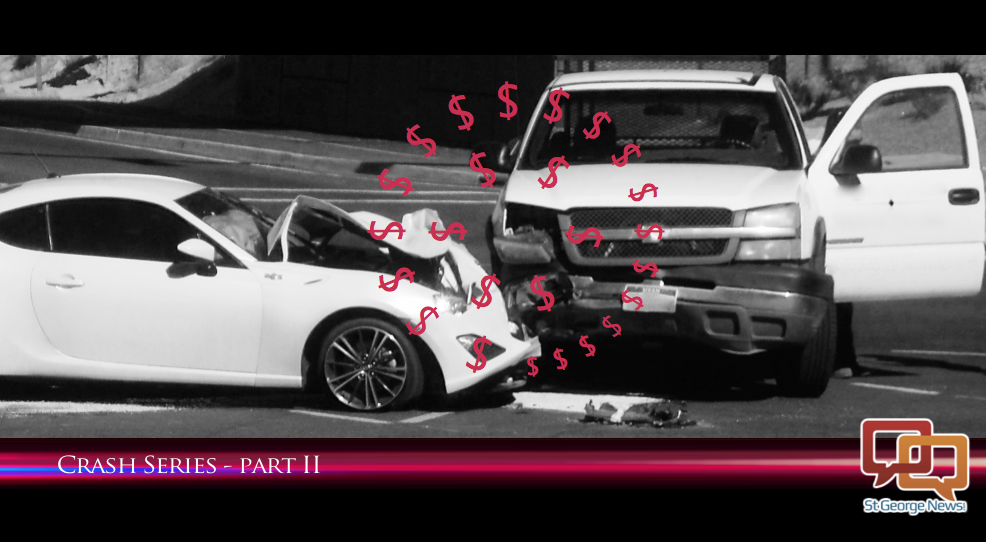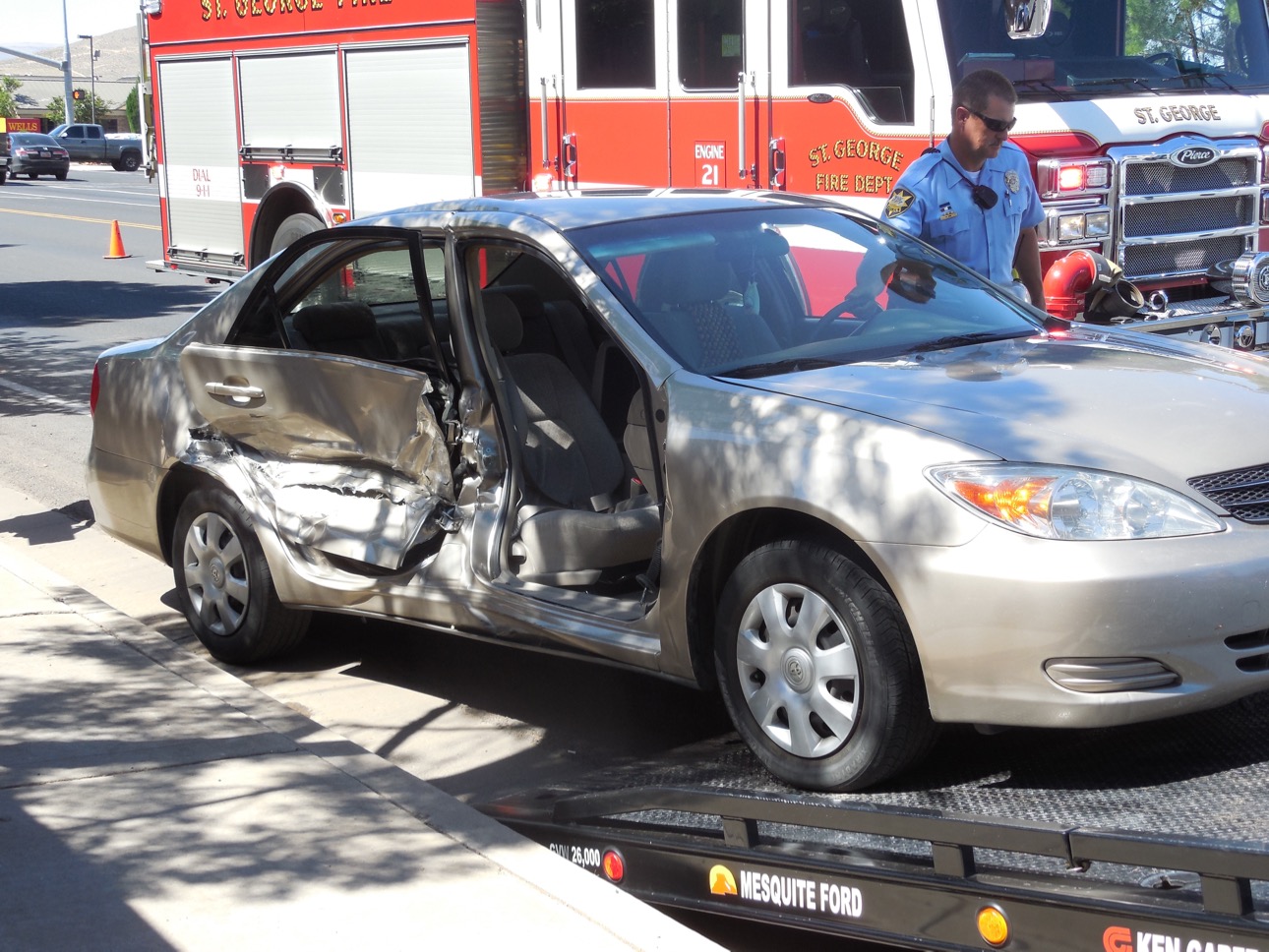ST. GEORGE — Car crashes impact more than just car insurance rates, and the financial aftermath affects every driver in St. George, the state and people across the nation. The highest price that is paid is loss of life but society bears the brunt of numerous other costs associated with car crashes; 2017 may ring in more than just a new year for many drivers as those costs continue to climb.
Nearly 40,000 people die on U.S. roadways each year. The public accepts that incomprehensible number without a lot of public outcry.
On the flip side, the topic of traffic congestion is frequently brought up in public conversation, so policymakers tend to focus on congestion relief as opposed to traffic safety, according to a 2009 report comparing the economic cost of congestion to the costs of crashes.
The report showed that the cost of crashes exceeded the cost of safety at a rate of more than 2 to 1.

In this Part II of a St. George News series, “St. George crashes,” we asked people and a few officials about their experiences with crashes and their impacts. Click the play arrow at the top of this report to see what they had to say.
Following are some hard facts.
Total cost of crash-related deaths in Utah in 2014: $268 million.
Average cost of a two-car crash: with no injuries, more than $6,000; with injuries, nearly $22,000.
Those are only the costs directly associated with damage and injuries involved. They don’t include the costs associated with responders, such as police, firefighters, paramedics and ambulance.
In 2015 there were 2,166 crashes in St. George, or 180 crashes per month on average, Sgt. Craig Harding, traffic supervisor for St. George Police Department, said. Using hourly data, those numbers amount to more than 5,400 hours of officer time over the entire year. This is equivalent to one officer working 24 hours a day for 225 straight days.
This year, the total number of crashes in St. George is already up by 10 percent, Harding said, so costs will be even higher.
To show the financial impact on troopers statewide, Utah Highway Patrol public information officer Sgt. Todd Royce provided an estimated cost breakdown for the time troopers spent at a crash site, in crash investigations and in reporting.
In 2015, UHP troopers spent more than 39,000 hours at crash sites and followups, Royce’s estimates show. This includes crashes that called additional troopers to the scene. The estimated cost was nearly $900,000 for that year. That cost is equivalent to four troopers spending more than 12 straight months working 24 hours a day dealing with crashes only.

With more cars on the road, the numbers have been increasing over the last few years, he said; instead of taking a proactive stance to deal with it, the UHP is taking a reactive stance.
“With the increase in crashes we are dealing with them as they happen,” Royce said, “when we would rather spend more time preventing them through education and enforcement.” His expounding on this is included in the video top of this report.
In Utah, the estimated statewide economic loss in 2013 due to motor vehicle crashes exceeded $1.6 billion, according to a 2013 report by the National Highway Traffic Safety Administration. This is the equivalent of $534 for every man, woman and child living in the state.
The increase in accident numbers as well as the rising costs of medical care and repair costs can directly affect insurance rates. In 2015, fatalities were higher nationwide than they’ve been since 1966, and in 2016 those numbers are still climbing.
“In years past, the cost associated with car crashes continued to rise, as crash numbers continued to drop,” James Lynch, chief actuary for the Insurance Information Institute, said in an October statement, “but now they are both rising.”
As a result, insurance rates are rising.
“There has been an alarming increase in crashes and claims reported,” Lynch said in the Institute’s statement. “This, combined with the cost of the claims themselves, has led to a dramatic rise in the overall loss cost.”
One agent in St. George said that more than $1 billion in claims nationwide were paid by one insurance carrier in 2015 alone.
Even with those rate hikes, Utah isn’t paying as much as many other states. In a ranking of highest to lowest premium costs associated with the states, Utah ranks No. 38, according to an analysis conducted in 2013 by the Insurance Information Institute.
Fast facts on car crash costs:
- Twenty-eight percent of all fatalities involve speeding, costing Americans more than $51 billion per year.
- Crashes where speeding and drunk driving are involved account for 41 percent of all crashes, at a cost of nearly $60 billion.
- In 2014 more than 163 billion text messages were sent all over the U.S. – every month.
- It takes an average time of 5 seconds to send or read a text, which is the equivalent of driving the entire length of a football field blindfolded.
- At any given daylight moment, more than 660,000 vehicles across the country are being driven by someone using a hand held cell phone.
- Distracted driving accounts for 17 percent of all costs associated with crashes, costing Americans more than $45 billion in 2014.
- Americans spend more than 1 million days per year in the hospital from car crashes.
- For every 1 person killed in a car crash, 8 people are hospitalized and 100 are treated and released from hospital emergency departments. That isn’t counting those treated at the scene by paramedics and the like.
About the series, “St. George crashes”
“St. George crashes” is a St. George News series exploring vehicle crash causes and effects in the immediate region and to some extent statewide and beyond. See the rest of the reports in the series:
Resources
- The Impact of Crashes – 2009
- Insurance Information Institute
- Motor Vehicle Crash Deaths: Costly but Preventable
- AAA’s 2015 American Driving Survey
- U.S. Census Bureau 2015 Driving Statistics
- Distraction.gov
Email: [email protected]
Twitter: @STGnews
Copyright St. George News, SaintGeorgeUtah.com LLC, 2016, all rights reserved.
I don’t worry about the traffic my chauffeur has 2 deal with that. I’m busy with counseling politicians and dealing with legal issues facing the international community and global marketing.
Pills.
Ha ha made you comment !
It seems like there is very little or no law enforcement, maybe there are other much higher priorities, like drug enforcement and they don’t have the resources to enforce traffic laws, and its not just st george, its all the surrounding areas, but every time I drive I witness,
1 failing to yield, 2 speeding 3 tailgating, 4 no blinker, 5 aggressive drivers (including cdl drivers) , if law enforcement is not going to enforce the law, then st george will remain the city with the absolute worst drivers in this country, when you throw in the fact that there is a much larger than average percentage of drivers with no auto insurance and the dmv and law enforcement cannot work together to enforce auto insurance, then we have the situation that we have right now.
I also think two groups make up the majority of the uninsured drivers, polys and the underpaid ill-legal immigrants.
Excellent, thorough analysis. You nailed it on the cause-and-effect. Driving in St George isn’t that much different than driving in a Third World city; we’re just missing the beggars at the traffic lights.
Don’t forget those that think the yellow light means go faster, and the red light means go not stop. Also, those who think they need to yap on their cell phones while driving, and worst of all, texting while driving. I swear if someone hits me while on their phone, if I’m not seriously injured or dead, I will grab their phone and destroy it, or better yet, shove it where the sun doesn’t shine.